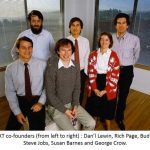In early 2003 Actel announced a new product family: RTSX-A. It was a family of antifuse FPGAs aimed at the satellite market. Customers had known for a long time that it was coming and there had been prototypes available for many months. Our space customers loved the product. This was going to be a big win for us! One of the first… Read More
Author: John East
Crashing the Mars Rovers!!! Actel and Aerospace Corp
Actel Goes Public – The IPO
In 1990 Xilinx notified us that they believed Actel was infringing a patent that had just been issued to them. My immediate thoughts – the patent system is all screwed up! Actel had been developing our product for five years. We had been shipping it for a year and a half. During all that time, we were totally unaware that there was … Read More
More Actel Foundry Woes: Andy Grove and Intel
The foundry problem continued to plague us at Actel. We had a really complex process! But —- we needed state of the art feature sizes if we were to compete with Xilinx. TI and Matsushita had been doing a good job for us, but not in fabs with state of the art technology. We were two process generations behind! At two generations… Read More
Actel TI and TSMC Foundry Woes
TSMC was founded in 1987 by Morris Chang. At about the same time, I was wrestling with the question of whether or not to join Actel. Morris had been a top executive at Texas Instruments during the period when TI took ownership of the TTL market. (See my week #8. Texas Instruments and the TTL Wars) I have to admit that when I first … Read More
From AMD to Actel (to Microchip)
By the late 80s it had become clear to me that the Japanese were right. Memories, Microprocessors, and Gate Arrays (As well as ASICs) were what customers wanted then. “Building blocks of ever-increasing complexity” was obsolete. What next? Should I try to become an overnight networking expert? Maybe a DSP expert? Pretty… Read More
What Fairchild, AMD, Actel and Jurassic Park Have in Common
Me.
In the early stories of this series (Weeks three though six), I talked about what I believe were the three seminal events in the history of the semiconductor: Shockley’s invention of the transistor, Noyce’s invention of the integrated circuit, and Intel’s 1971 — the introductions of the first commercially successful… Read More
More Steve Jobs, Apple, and NeXT Computer
My first meeting with Steve Jobs was in early 1987 when he was running NeXT Computer. I was a VP at AMD and was hunting for potential customers. I visited him in the NeXT Palo Alto facility with the objective of selling him some existing AMD products. He had a different objective: to get me to produce a new product that we had no plans… Read More
Steve Jobs, NeXT Computer, and Apple
From time to time I give presentations to various audiences: Silicon Valley the Way I Saw It. I always enjoy doing that. One particular section always makes me stop and think. “Who was this guy? How did he do what he did? Why didn’t I do that? “What made him so special?” It’s the Steve Jobs section. I met twice with Steve Jobs when … Read More
Intel, Motorola, and the IBM PC
Wikipedia … “In chaos theory, the butterfly effect is the sensitive dependence on initial conditions in which a small change in one state of a non-linear system can result in large differences in a later state”. In other words, a butterfly bats its wings in Argentina and the path of an immense tornado in Oklahoma is changed some… Read More
Real Men Have Fabs Jerry Sanders, TJ Rodgers, and AMD
In 1977 I made a job change: I took a job at Raytheon Semiconductor. Raytheon was on Ellis Street next door to the Fairchild “Rust Bucket”. In the early days, they shared the same parking lot so my commute didn’t change much, but my outlook on life changed a bunch. I had mostly enjoyed my days at Fairchild, but I hated every single … Read More





















Quantum Computing Technologies and Challenges